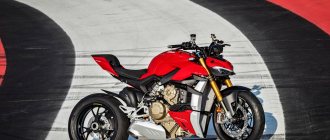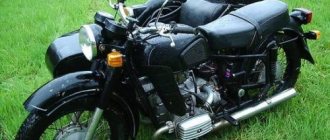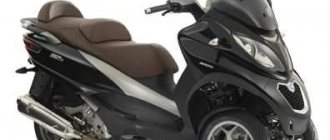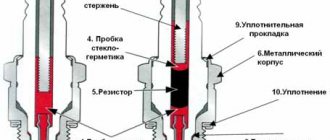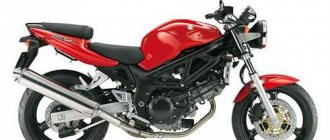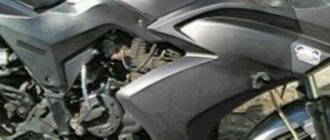000_moto_0712_012
Statistics are a stubborn thing: before the appearance of the 1199 Panigale, the most popular Ducati sportbike in Europe was not the “top-end” 1198SP, but the obviously more modest 848 EVO. I must say, so do we. Is this why, in the two years since its debut, it has not been possible to find an Evo available for testing from a Russian dealer? It may well be. But the meeting still took place. Even if for this I had to go to Italy - to the Adria International Raceway.
The sports complex in Adria cannot be called super-fast. At the end of the longest start-finish straight, you rarely see a speed higher than 215 km/h on the electronic speedometer screen out of the corner of your eye. But here there are an abundance of turns of varying degrees of steepness in second and third gear, where the main differences between generations appear especially clearly.
Externally, it looks like an “eight hundred and forty-eighth” model of 2007 (“Moto” No. 10–2010). All the same complexly coupled and at the same time harmonious surfaces by Gianandrea Fabbro. All the same frame, suspension, wheels... Virtually no changes. But against the backdrop of the revolutionary Panigale, the design of the 848 EVO, which instantly became a classic, does not look outdated, and the soul still experiences genuine delight from contemplation. Perhaps one of the most beautiful mid-sized sportbikes. And unmistakably - Ducati!
You feel that you belong to the brand not even by looking at it, but by touching it while sitting in the saddle. The pilot's spacious and balanced workstation is very familiar. The body is noticeably tilted forward, but without excessive fanaticism. High footrests and moderately wide clip-ons. Gas tank with proper stampings under the knees. It's comfortable to sit, but... not for urban conditions. And for the track? Just a second ago you were still “pressing”, hiding from the oncoming flow behind the low glass of the “Italian”, and a moment later you straightened your shoulders, rose towards the dense air and slowed down before the next arc. And this transition from one state to another occurs so naturally that it does not require focusing on details. Everything is as it should be: the body is tightly connected to the motorcycle, the hands are free. No tightness.
The new 848 EVO engine carefully suggests that it was worked on by the same group of engineers who then gave birth to the 1199 Panigale about a year later. Apparently, in both cases they set themselves similar goals, namely to get as close as possible in terms of power output to their “four-cylinder” competitors. Having slightly shaken up the well-deserved “two” Testastretta with a belt drive of camshafts and adding the prefix Evoluzione to its name, Ducati motorists have retained the “desmodromic” architecture. In fact, they made do with a light classic tuning: they modernized the intake and exhaust ports in the cylinder heads, revised the shape of the combustion chamber and piston crown, raised the compression ratio to 13.2:1 (versus 12:1 previously), borrowed an injection unit from the older “sport” 1198 with elliptical diffusers of larger diameter (equivalent to Ø60 mm), increased valve overlap (from 253° to 257°) and their lift (intake from 11.5 mm to 13 mm, exhaust from 10.7 mm to 11.6 mm) . The result of the work, according to the documents, is modest: only six additional forces and two newton meters were found.
But by the standards of mid-size bikes, the Ducati 848 EVO rides very well! The short-stroke “two” bubbles with a dry exhaust rumble from idle. True, you don’t want to enjoy low-frequency baritones - despite the linear nature of the power increase, below 5000 rpm the power unit looks like a sleepy, lazy cat. Therefore, in order to stir it up and achieve the desired acceleration, and at the same time feel the promised increase in strength, you have to be bolder and more assertive with the throttle. Fortunately, the injection settings allow this. That's when the true, dramatic voice and nature awaken. The engine roars voluptuously under thrust, groans when the gas is released and chokes on the vacuum in the pipes when the throttle is fully closed. Through simple manipulations, Ducati engineers seem to have awakened his appetite! Now he greedily swallows the revolutions and unusually early finds himself at the limit of 11,300 rpm, where he gently rests against the limiter. But in order to revel in the dynamics and acoustics all the time, you need to “drive” all the time, continuously clicking the tight gearbox that requires “resetting”. After all, there is no “meaty” “middle” so characteristic of the V2 - all the passion of the engine is at the “top”, after seven thousand. Peak power occurs at 10,500 rpm. It's like it's not a twin at all!
It’s a pity that the sporty Ducati never got a slipper clutch. It would be nice in one basic version, where such savings are usually perceived as a marketing ploy. But the advanced 848 EVO Corse SE, which sports an Öhlins shock absorber and traction control as standard, is also deprived of it. They could have been generous with her! And if everything is tied to the budget, for the sake of such traction one could sacrifice traction. Moreover, both Sigma and STM have been offering similar units on the aftermarket market for a long time. However, given the not very impressive volume of cylinders, the absence of a “slipper clutch” makes itself felt rarely. Usually at the end of long straights, when before slow turns you have to sharply stop the motorcycle and drop from fourth gear to second, accompanying the whole process with a cheerful bark of throttle changes. The basic rule is not to overdo it with heavy engine braking and carefully count the gears (the Digitek instrument panel is not trained to display their number) in order to spare the valve desmo and not over-torque the engine.
But the behavior of the 848 EVO on the track remains essentially the same. Clear and intuitive. With a translucent touch of stubbornness.
The way the Showa front “shifter” handles storming curbs and aggressive braking even on “stock” settings is worthy of respect. As, indeed, is the rear shock absorber of the same brand, which can only be blamed for inconvenient access to the rebound adjustment screw (through the hole in the pendulum). Moreover, the level of “feedback” (feedback) from the suspensions is quite sufficient! Not yet “high-end” from authoritative Italian specialists from the Andreani company, who ate more than a pound of salt when fine-tuning Öhlins, but no longer banal consumer goods. And if you match the springs to the weight of the pilot, I suspect they will work even better.
As before, the Ducati gets into the arc with a slight amount of obstinacy, requiring a steady hand, which is especially noticeable on fast changes and in sharp hairpins. Although, it seems that this defect has been significantly smoothed out due to the sharper profile of the new Pirelli Diablo Supercorsa SP tires. However, once you get the bike to start turning, it pleasantly surprises you with its rock-solid lean stability without any attempts to leave the line. After two or three laps on the technical Adria track, confidence comes. I do what I want with the motorcycle, and it helps me! The behavior is equally good and predictable at all stages of cornering. He just doesn't need to be disturbed! It is paradoxical that the Panigale S, tested several months earlier, in some situations forced us to adapt to barely expressed nervousness in habits, while the EVO is almost a monolith! Probably, this is due not only to the tightly built chassis, but also to the non-adjustable steering damper, also borrowed from the 1198 model. Perhaps - because I never felt any active intervention during the entire track day.
Among other things, Brembo brake mechanisms were also adopted from the “eleven ninety-eight”: monoblock four-piston radial calipers and discs with a diameter of 320 mm (for the EVO Corse SE - 330 mm). Compared to other improvements, this is what seems most appropriate and most effective. Questions regarding composite brackets did not arise exclusively within the framework of civilian use; there were frankly few of them for sports. Now it seems that almost all the brakes in the world are hidden under the right lever, whose transparency and information content certainly does not raise doubts. No ABS needed!
And what happens overall? I'm afraid to overpraise Ducati's "junior superbike". How many times has it happened when, upon returning from a presentation or other “hothouse” test, I wanted to talk about technology excitedly, but when confronted with direct competitors, everything turned out differently. By the way, there are not so many of them: Suzuki GSX-R750, Triumph Daytona 675R and... that's it! But for now... For me, the Ducati eight-four-eight-evo is the quintessence of pure, uncomplicated communication between driver, machine and road. And the fact that he performs in his own league, which does not fit into the framework of international sports classes, is not at all scary. This is not what affects popularity. It’s just that in this case the main thing is not numbers, but emotions.
Description Ducati Streetfighter 848 2014
The description of the Ducati Streetfighter 848 2014 motorcycle is in the queue for publication of the article. Announcement: Today, for almost every new motorcycle that comes into being, marketers strive to carve out their own niche. This one is a road sport, this one is a recreational enduro. But what class should we include a motorcycle that has a little bit of everything? A good bike should have a reliable engine, comfortable ergonomics and simple controls...
The Ducati Streetfighter 848 is a very rare motorcycle in Russia equipped with a fairly powerful 132hp engine. Despite the fact that good models of motorcycles have a very respectable price, and the season for their use is relatively short, the motorcycle market is developing rapidly. And if you believe the words of dealers, then some models of recently released motorcycles are selling like hot cakes at the beginning of the season, and the models brought to Russia are clearly not enough to fully satisfy consumer demand.
A motorcycle has long ceased to be an alternative to a car, and the times when this equipment was bought only because there was not enough money for a full-fledged car are forgotten. Nowadays, two-wheelers can be called technological marvels in many cases, and their cost can be compared with that of prestigious cars.
Many people have started buying motorcycles for hobby purposes as riding or even collecting them has become a good pastime for many people. Many motorcycles, for example the Ducati Streetfighter 848, whose technical characteristics make it possible to call the model a prestigious brand, are in demand among both beginners and experienced motorcyclists.
Motorcycles with an engine capacity of 849 cc. see, appeared as a result of long work of inventors who sought to create a model that was not inferior in characteristics to other versions of the motorcycle. In some cases, these models are not only not inferior, but also ahead of other motorcycles, as they have minimal fuel consumption and other excellent parameters.
Motorcycles with an engine capacity of more than 400 kb. cm, which includes the Ducati Streetfighter 848 - this category of motorcycles simply cannot claim the title of “motorcycle for a beginner.” On the contrary, this is already a serious technique that requires certain control of motorcycle equipment with a smaller engine capacity. Yes, she attracts more attention, she is the most beautiful, fast, interesting and there is a huge selection of models. But as power increases, the weight of the motorcycle inevitably increases. In this class you are unlikely to find motorcycles lighter than 180 kg, unless they are the latest motorcycle models.
003_moto_0712_012
Brembo four-piston monoblocks were borrowed from the 1198. But if the standard versions of the Ducati 848 EVO have front discs with a diameter of 320 mm, then the “special” EVO Corse SE has 330 mm.
Brembo four-piston monoblocks were borrowed from the 1198. But if the standard versions of the Ducati 848 EVO have front discs with a diameter of 320 mm, then the “special” EVO Corse SE has 330 mm.
Ducati Streetfighter 848 Concept (Ducati Streetfighter 848)
Ducati Streetfighter 848 (Ducati Streetfighter 848) is one of the brightest representatives of the class of motorcycles of the same name and its creation history is traditional for this type of bike. The popular sports model Ducati Superbike 848 EVO was taken as a basis, from which the Streetfighter got an excellent engine, chassis, suspension and brakes. At the same time, the appearance of the motorcycle was redesigned according to the “laws of the genre” - a minimum of fairings and an aggressive, “naked” design. The combination of a cutting-edge sports engine and outstanding aggressive design makes the Ducati Streetfighter 848 an icon of modern naked bikes.
005_moto_0712_012
Unfortunately, access to the rebound adjustment on the rear shock absorber remains extremely inconvenient - through a hole in the swingarm.
To change the settings you will need a very long screwdriver. Unfortunately, access to the rebound adjustment on the rear shock absorber remains extremely inconvenient - through a hole in the swingarm. To change the settings you will need a very long screwdriver.
Operating costs
If operating costs are of significant importance to you, then it is recommended to avoid any product from Italian manufacturers, no matter whether it has two or four wheels. Although, when compared with other Ducati models, the Streetfighter 848 will empty your wallet to a much lesser extent than, for example, a Monster or Hypermotard 796. Even if you look at fuel consumption, 5.9 liters per 100 km is a pretty good indicator, meaning a range of 225 km between refuelings.
Our rating: 3 out of 5
008_moto_0712_012
The European and American versions can most easily be distinguished by their mufflers: on the European version they are installed almost flush with the tail plastic, while on the American one they protrude noticeably beyond it.
Unfortunately, the changes made for the sake of certification in the North American market led to a noticeable reduction in power. The European and American versions can most easily be distinguished by their mufflers: on the European version they are installed almost flush with the tail plastic, while on the American one they protrude noticeably beyond it. Unfortunately, the changes made for the sake of certification in the North American market led to a noticeable reduction in power.
Five random articles about motorcycles:
JAWA 210 AUTOMATIC
JAWA 210 AUTOMATIC JAWA mopeds, produced in Považska Bystrica (Czechoslovakia), continue the tradition of the plant, where in the post-war years they made micromotorcycles "Manet", and in the 50s - "JAWA Pioneer", JAWA-50, which were also supplied to our country. Among its current products are the YAVA-207 mopeds, also known under the “Babette” brand (“Behind the Wheel,” 1980, No. 5). Inexpensive, fuel-efficient cars are quite popular; 80% of their output is exported to 35 countries. Recently, the plant mastered another moped model - YAVA-210. Its clutch and gearbox are automatic, making the moped especially easy to operate. It also has a foot pedal drive. A single-seater car reaches a speed of up to 40 km/h. Shoe wheel brakes are operated by levers on the steering wheel. Technical characteristics of the moped Java 210 automatic General data: curb weight - 54 kg; load capacity (including 5 kg of luggage) - 90 kg; speed - 40 km/h; fuel reserve - 3.8 l; exp...
Recommendations for owners of heavy motorcycles
I do this... The author of the proposed material is engineer S. NAUMOV from the city of Irbit, an experienced motorcycle tourist who has repeatedly participated in long-distance and difficult test and tourist trips on Ural motorcycles. His recommendations, prompted and tested by experience, will undoubtedly be useful to all owners of heavy motorcycles. And maybe not only them. For ease of presentation, I have divided my proposals by topic. And I'll start with electrical equipment. To facilitate the installation of two series-connected ZMT-6 batteries, you need to cut a 30 mm wide ring from an old motorcycle camera and put it on two cans at once. Or better yet, two such rings, placing them at the top and bottom of the jars. Rice. 1. Connecting the terminals of two batteries with a plate, installing a rubber ring 30 mm wide. I advise you to connect the “+” terminals of one battery and the “-” terminals with another plate made of stainless steel or tinned copper (Fig. 1), and the terminals from which...
Conversion of Java electrical equipment 6V to 12V
Remaking the electrical equipment of Java Our magazine has repeatedly discussed the shortcomings of the power supply of the YAVA-634 motorcycle, produced before 1985. At low crankshaft speeds (up to 1800 per minute), the 6-volt generator does not produce energy, and all consumers at this time are powered by the battery. If the lights and headlights are on, the battery is quickly discharged, which, with repeated cycles, leads to its failure. The only measure to avoid this trouble is to maintain medium speed even on bad roads or stops at intersections. It is clear that this causes great inconvenience, especially for residents of rural areas. The currently produced YABE model “638” uses a 12-volt electrical system (its description and diagram are given in No. 6, 1987), where a more advanced and powerful generator begins to work already at 1000 rpm. It is clear that many owners of the old model want to switch to new electrical equipment, but encounter an obstacle:...
Repair of the central stand on an IZH motorcycle
On IZH motorcycles, as a result of wear of the stops welded to the frame, the central stand twists and breaks the stops. There is no need to weld them again. since this is quite difficult and not harmless to the frame. Installation of stops on the stand: 1 stand; 2 - stops. I, and then several other IZh owners, welded stops (plates cut from a steel sheet 5 mm thick) to the stand itself, as shown in the figure. For several years now, converted coasters have not given us any trouble. N. MELANKO 330067, Zaporozhye, st. Uchitelskaya, 17a 1976N01P38
013_moto_0712_012
By the standards of mid-size bikes, the Ducati 848 EVO rides very well.
By the standards of mid-size bikes, the Ducati 848 EVO rides very well.
RESULT. It’s strange to talk about a motorcycle “junior” or “first superbike” when it has the power capacity of a Ducati 999 produced in 2006. Meanwhile, “the first superbike” and “the first motorcycle” are not the same thing. Technical evolution has not brought any fundamental changes, but thanks to it, the Ducati 848 EVO is not too lost even in the company of the 1199 Panigale.
| Ducati 848 EVO (manufacturer data) | |
| COMMON DATA | |
| Model year | 2012 |
| Dry weight, kg | 168 |
| Curb weight, kg | 194 |
| Length × height, mm | 2100 × 1100 |
| Base, mm | 1430 |
| Seat height, mm | 830 |
| Gas tank volume, l | 15,5 |
| Steering column tilt angle, degrees. | 24,5 |
| Reach, mm | 97 |
| ENGINE | |
| Type | L2, 4T |
| timing belt | Desmodromic, 4 valves per cylinder |
| Working volume, cm³ | 849,4 |
| Cylinder diameter × piston stroke, mm | 94,0 × 61,2 |
| Compression ratio | 13,2:1 |
| Supply system | Marelli injection, oval diffuser (Ø60 mm equivalent) |
| Power, hp at rpm | 140/10500 |
| Torque, Nm at rpm | 98/9750 |
| Cooling system | liquid |
| Starting system | electric starter |
| TRANSMISSION | |
| Clutch | multi-disc, oil bath |
| Transmission | 6-speed |
| main gear | chain |
| CHASSIS | |
| Frame | spatial tubular, steel |
| Front suspension | Showa telescopic fork, inverted, fully adjustable |
| Pipe diameter, mm | 43 |
| Wheel travel, mm | 127 |
| Rear suspension | pendulum with Showa monoshock absorber and progressive characteristics, fully adjustable |
| Wheel travel, mm | 120 |
| Brake system | separate, hydraulic |
| Front brake | two discs, Ø320 mm, 4-piston Brembo radial calipers |
| Rear brake | disc, Ø245 mm, 2-piston caliper |
| Wheels | aluminum alloy |
| Front tire | 120/70–17 |
| Rear tire | 180/55–17 |
The test is organized.
Berik, Arlen Ness and Suomy equipment provided by.
EVOlution: Ducati 848 EVO
Ducati Track Control (DTC):
It uses the same software logic that was developed and used by the Ducati Corse racing division for motorcycles that have competed in MotoGP and World Superbike, and offers eight engine modes developed by a team of professional test riders and racers. When the mode that best is selected Suitable for a combination of given road or track conditions and riding style, the Track Control (DTC) system is activated, compares the signals from the front and rear wheel rotation sensors and the speed difference, and monitors rear wheel slip (wheel slip). DTC calculates the best combination of two different electronic controls, taking into account data that comes from several sources.
Handling and ride quality
To the layman's eye, the Streetfighter looks very similar to its larger 1099cc Streetfighter S sibling - the same aggressive look, similar chassis and superbike-style frame, but the Ducati Streetfighter 848 has slightly lower specs for the suspension (Sachs) and braking system ( Brembo).
Handling is impeccable. Moreover, both on city streets and when driving on the highway. The Ducati Streetfighter 848 is nimble, precise, agile and very stable. The brakes are very powerful without being overly harsh. Its suspension provides a fairly comfortable ride and does not allow you to deviate from the course during high-speed turns, even on not very good surfaces.
If you are lucky enough to find yourself on the track with the Ducati Streetfighter 848, then you will definitely appreciate the 8-level traction control system and lap time counter. Although many believe that such a sophisticated traction control system for a road motorcycle is an unnecessary option.
Our rating: 5 out of 5
Practicality
The rider's position takes some time to get used to, as does getting in and out, and all because the rear part of the seat is raised too high for the passenger.
In order not to experience inconvenience, you need to either have long legs or be quite athletic, or better yet, both together. The almost flat handlebar of the Streetfighter seems shortened compared to a sportbike equipped with clip-ons, but still, in difficult city traffic it is quite difficult to handle and you feel like you are “sitting on a perch”, somehow not very comfortable.
By the way, the fact that the Ducati 848 is not ideal for touring is not at all surprising. An aggressive, forward-leaning riding position is unlikely to be conducive to long travel. And although the Ducati Streetfighter 848 has plenty of power and speed, the heat from the exhaust system will cause discomfort on your heel on the right, and the optional windshield, due to its small size, will not provide good protection from wind and bad weather. In addition, it does not have any special compartments for storing things, which is very important for touring motorcycles.
Our rating: 2 out of 5
Price
This Ducati Streetfighter 848 is quite comparable in price ($10,495) to its competitors: a fully loaded Triumph Speed Triple R costs about $11,000, and the less expensive MV Agusta Brutales costs $10,500. Of course, there is also a Kawasaki Z1000 for $9,128 and a KTM 990 Super Duke for $8945, and also the Speed Triple in the minimum configuration for 8799?, not to mention two Benelli TNT899 models priced at $7299 and $6499. But what is there to discuss - if you like a new, fast, red (or yellow or black) Ducati, then you will undoubtedly spend the money for it, which it is definitely worth.
Our rating: 3 out of 5
Reliability
If we talk about the old Ducati, then, of course, they were far from the reliable Swiss watch-like Japanese motorcycles, for example, such as Kawasaki. However, times are changing and in our case, fortunately, for the better - modern Ducati have become very close to perfection in the field of quality and reliability. And an example is our test motorcycle, which, both at the beginning and at the end of our numerous tests, did not raise a single complaint in this area.
Such impeccable performance is explained by many factors, for example, one of them is that the camshaft drive was borrowed from the Pantah model of the 80s, so over 30 years Ducati designers had enough time to improve this design.
Our rating: 4 out of 5
Accessories
Our test unit came equipped with the optional $217.5 windshield, and if you open the Ducati Accessories catalog, you'll have a good time choosing from the 70 available additions to your iron steed. They range from a $40 aluminum oil filler cap to a $3811.6 Termignoni racing exhaust system. But ABS is not available either as standard or as an option, since all the parts and mechanisms of the Streetfighter 848 are so tightly and compactly fitted that there is no room left for its control unit.
Our rating: 4 out of 5
